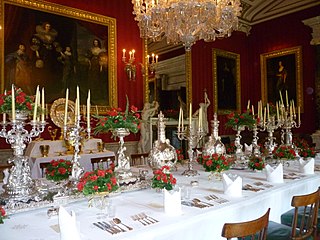 W
WTableware is any dish or dishware used for setting a table, serving food, and dining. It includes cutlery, glassware, serving dishes, and other items for practical as well as decorative purposes. The quality, nature, variety and number of objects varies according to culture, religion, number of diners, cuisine and occasion. For example, Middle Eastern, Indian or Polynesian food culture and cuisine sometimes limits tableware to serving dishes, using bread or leaves as individual plates. Special occasions are usually reflected in higher quality tableware.
 W
WThe Armada Service is a set of more than 31 gilded silver dishes, dated between 1581 and 1601, formerly owned by Sir Christopher Harris, MP, of Radford House in the parish of Plymstock in Devon, England. Twenty-six of these dishes are now in the collection of the British Museum in London.
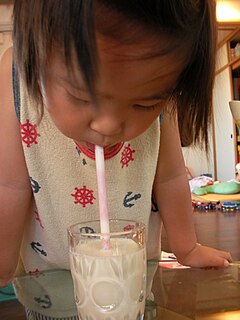 W
WAssistive eating devices include devices ranging from low-tech utensils to high-tech powered robotic eating equipment. Low tech eating devices include utensils, plates and bowls with lips that make scooping food easier. Cups and mugs, and even a standard disposable straw can be considered assistive drinking devices. They are used by people when they have difficulty eating or drinking independently. These devices are typically used for people with disabilities, but can also be used for children or people that have poor dexterity. They can promote independence during meal times, but in many cases also can reduce the caregiver workload during meals. "Assistive eating devices can increase self-care, increase self-esteem associated with increased independence, increase safety during meals, and make meal-time better for caregiver staff…".
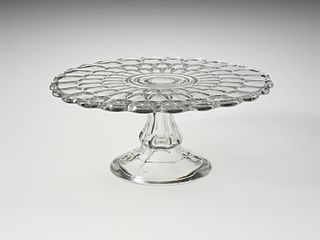 W
WA cake stand is a structural, stool like object on which cake and other pastries are decorated and served. Cake stands are generally a single plate connected to a pedestal or multiple plates in a tower like hosting object. Cake stands are a form of tableware, they come in different materials like wood, pottery, metal, etc.
 W
WThe Canadian Historical Dinner Service, originally called the Cabot Commemorative State Dinner Service, is 204-piece eight-course dinner service with 24 place settings of hand-painted porcelain. It was created in 1896–97 to commemorate the 400th anniversary of the first visit to Canada by a European, John Cabot. The illustrations all have Canadian subjects, and no two pieces are the same.
 W
WA centrepiece or centerpiece is an important item of a display, usually of a table setting. Centrepieces help set the theme of the decorations and bring extra decorations to the room. A centrepiece also refers to any central or important object in a collection of items.
 W
WA cloche is a tableware cover, sometimes made out of silver though commercially available as glass, stoneware, marble, or other materials. They often resemble a bell, hence the name.
 W
WDisposable tableware includes all disposable tableware likedisposable cups made of paper, plastic, coated paper, plates tablecloths, placemats plastic cutlery, paper napkins, etc.
 W
WDuralex is a French tempered glass tableware and kitchenware manufacturer located in La Chapelle-Saint-Mesmin in Loiret. Using a technique developed in the 1930s by Saint-Gobain, moulded glass is heated to 600 degrees Celsius, then cooled very quickly, giving it an impact resistance twice superior to normal glass.
 W
WEdible tableware is tableware, such as plates, drinkware and glasses, utensils and cutlery, that is edible. Edible tableware can be homemade and has also been mass-produced by some companies, and can be prepared using many various foods.
 W
WEpergne is a type of table centerpiece that is usually made of silver but may be made of any metal or glass or porcelain.
 W
WA finger bowl is a bowl of water that dinner guests use for rinsing their fingers. In a formal meal, the finger bowl is brought to the table at the time of the last course of the meal, and guests set it aside for use after the last course, just before leaving the table. In less formal service, the finger bowl may be presented after any course that involves finger food and may even be presented after more than one such course in a single meal.
 W
WThe Germain Service is an 18th-century tableware set comprising more than a thousand pieces in cast, raised, and chiselled silver, made in the workshop of French silversmith François-Thomas Germain for the Portuguese royal family. This service is now on permanent exhibition as part of the collection of the National Museum of Ancient Art, in Lisbon, Portugal.
 W
WGlass is a non-crystalline, often transparent amorphous solid, that has widespread practical, technological, and decorative use in, for example, window panes, tableware, and optics. Glass is most often formed by rapid cooling (quenching) of the molten form; some glasses such as volcanic glass are naturally occurring. The most familiar, and historically the oldest, types of manufactured glass are "silicate glasses" based on the chemical compound silica, the primary constituent of sand. Soda-lime glass, containing around 70% silica, accounts for around 90% of manufactured glass. The term glass, in popular usage, is often used to refer only to this type of material, although silica-free glasses often have desirable properties for applications in modern communications technology. Some objects, such as drinking glasses and eyeglasses, are so commonly made of silicate-based glass that they are simply called by the name of the material.
 W
WThe International Museum of Dinnerware Design (IMoDD) is a 501(c)(3) organization located in Ann Arbor, MI established in 2012 by the museum's founding director, Dr. Margaret Carney. IMoDD is a design museum that "collects, preserves, and celebrates masterpieces of the tabletop genre created by leading artists and designers worldwide. Through its collections, exhibitions, and educational programming," IMoDD's mission statement says, "it provides a window on the varied cultural and societal attitudes toward food and dining and commemorates the objects that exalt and venerate the dining experience." IMoDD has over 8,500 objects in it's permanent collection, consisting of work by contemporary artists as well as the leading designers for industry, with an additional focus on fine art referencing dining.
 W
WA mat is a hard rug that generally is placed on a floor or other flat surface. Mats serve a range of purposes including:serving to clean items passed over it, such as a doormat, which removes dirt from the soles of shoes protecting that which is above the mat, such as a wrestling or gymnastics mat, or an anti-vibration mat protecting that which is beneath the mat, such as a place mat or the matting used in archival framing and preservation of documents and paintings providing a regular or flat surface, such as a cushioned computer mousepad
 W
WA napkin holder is a device used to hold napkins. A napkin holder can be made from virtually any solid material and is built so that the napkins do not slip from its hold, either by way of sandwiching them between two surfaces, or simply enclosing them on their sides in a horizontal design. Napkin holders range in price and styles from wooden designs to wrought iron or ceramic styles and many others. One iteration of the napkin holder, better known as a napkin dispenser, offers additional functionality with its design: folded napkins are enclosed in a snug metal casing, allowing users to retrieve a single napkin each time they reach into the container; this particular device is usually found in restaurants, diners, and other public eateries, while its simpler—often more aesthetically pleasing—counterpart, the holder, is common to households and classrooms. There is also an item which holds a napkin or serviette in a button hole or the top of a conventional necktie knot. It is conjectured as a clamp for the corner of a napkin and an hook which hooks into the top of the tie knot. They are most usually in sterling silver and date back to at least Edwardian times. Hence often to be found in antique outlets as functional collectors items. Certain "gentleman's clubs" include a button hole in a corner of their napkins for direct coupling to an upper shirt button.
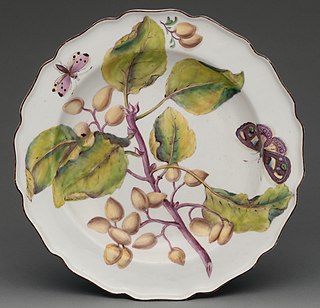 W
WA plate is a broad, concave, but mainly flat vessel on which food can be served. A plate can also be used for ceremonial or decorative purposes. Most plates are circular, but they may be any shape, or made of any water-resistant material. Generally plates are raised round the edges, either by a curving up, or a wider lip or raised portion. Vessels with no lip, especially if they have a more rounded profile, are likely to be considered as bowls or dishes, as are very large vessels with a plate shape. Plates are dishware, and tableware. Plates in wood, pottery and metal go back into antiquity in many cultures.
 W
WA platter is a large type of dishware used for serving food. It is a tray on which food is displayed and served to people. Its shape can be oval, round, rectangular, or square. It can be made of metal, ceramic, plastic, glass or wood. Plain and ornate platters suitable for more formal settings or occasions are made of, or plated with, silver, and antique examples are considered quite valuable. Especially expensive and ceremonial platters have been made of gold.
 W
WPorcelain is a ceramic material made by heating substances, generally including a material like kaolin, in a kiln to temperatures between 1,200 and 1,400 °C. The strength, and translucence of porcelain, relative to other types of pottery, arises mainly from vitrification and the formation of the mineral mullite within the body at these high temperatures. Though definitions vary, porcelain can be divided into three main categories: hard-paste, soft-paste and bone china. The category that an object belongs to depends on the composition of the paste used to make the body of the porcelain object and the firing conditions.
 W
WRestaurant ware, or most commonly hotelware is vitrified, ceramic tableware which exhibits high mechanical strength and is produced for use in hotels and restaurants. Tableware used in railway dining cars, passenger ships and airlines are also included in this category.
 W
WA salad bowl is a bowl-shaped serving dish used to serve salads, especially tossed salads.
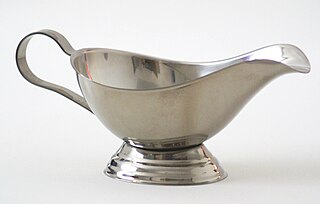 W
WA sauce boat, gravy boat, or saucière is a boat-shaped pitcher in which sauce or gravy is served. It often sits on a matching plate, sometimes attached to the pitcher, to catch dripping sauce.
 W
WThe Service of the Viscounts of São João da Pesqueira is an early 20th-century three-hundred piece tableware set in cast silver, made in Porto, Portugal, in the Reis & Filhos workshop.
 W
WStoneware is a rather broad term for pottery or other ceramics fired at a relatively high temperature. A modern technical definition is a vitreous or semi-vitreous ceramic made primarily from stoneware clay or non-refractory fire clay. Whether vitrified or not, it is nonporous ; it may or may not be glazed. Historically, across the world, it has been developed after earthenware and before porcelain, and has often been used for high-quality as well as utilitarian wares.
 W
WA tablecloth is a cloth used to cover a table. Some are mainly ornamental coverings, which may also help protect the table from scratches and stains. Other tablecloths are designed to be spread on a dining table before laying out tableware and food. Some tablecloths are designed as part of an overall table setting, with coordinating napkins, placemats, or other decorative pieces. Special kinds of tablecloth include "runners" which overhang the table at two ends only and "table protectors" which provide a padded layer under a normal tablecloth.
 W
WTiffany & Co. is an American luxury jewelry and specialty retailer headquartered in New York City. It sells jewelry, sterling silver, china, crystal, stationery, fragrances, water bottles, watches, personal accessories, and leather goods. Tiffany is known for its luxury goods, particularly its diamond and sterling silver jewelry. These goods are sold at Tiffany stores, and through direct-mail and corporate merchandising.
 W
WA toast rack or toastrack is a serving piece having vertical partitions connected to a flat base, used for holding slices of toast. It often has a central ring handle for carrying and passing round the table.
 W
WA trencher is a type of tableware, commonly used in medieval cuisine. A trencher was originally a flat round of bread used as a plate, upon which the food could be placed to eat. At the end of the meal, the trencher could be eaten with sauce, but could also be given as alms to the poor. Later the trencher evolved into a small plate of metal or wood, typically circular and completely flat, without the lip or raised edge of a plate. Trenchers of this type are still used, typically for serving food that does not involve liquid; for example, the cheeseboard.
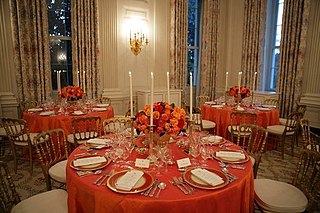 W
WThe White House china refers to the various patterns of china (porcelain) used for serving and eating food in the White House, home of the president of the United States. Different china services have been ordered and used by different presidential administrations. The White House collection of china is housed in the White House China Room. Not every administration created its own service, but portions of all china services created for the White House are now in the China Room collection. Some of the older china services are used for small private dinners in the President's Dining Room on the Second Floor.